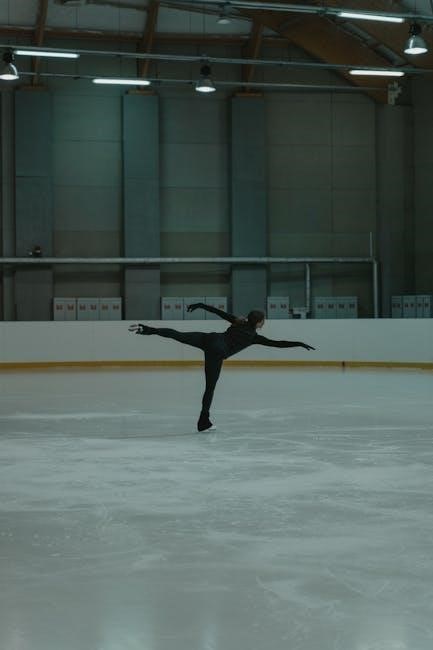Osgood-Schlatter disease is a self-limiting inflammatory condition affecting the knee, commonly seen in adolescents during growth spurts. It causes pain and swelling below the kneecap at the tibial tubercle, often linked to sports activities.

Stretching Exercises for Osgood-Schlatter Disease
Stretching is crucial for managing Osgood-Schlatter disease, targeting the quadriceps, hamstrings, IT band, and calf muscles. Regular stretching helps reduce tension, improve mobility, and alleviate pain around the knee area.
Quadriceps Stretch
The quadriceps stretch is a fundamental exercise for managing Osgood-Schlatter disease, targeting the front of the thigh. To perform this stretch, lie on your stomach with one leg bent behind you. Grasp your ankle with your hand and gently pull your heel toward your buttocks until a stretch is felt in the front of your thigh. Hold this position for 20-30 seconds and repeat 2-3 times on each leg. It’s important to maintain a straight knee and avoid bouncing, as this can cause discomfort. This stretch helps reduce tension in the quadriceps muscles, which are often tight in individuals with Osgood-Schlatter disease. Regular practice can improve flexibility and alleviate pain around the knee area. Consistency is key, as stretching should be done daily to maximize benefits and support recovery.
Hamstring Stretch
The hamstring stretch is another essential exercise for managing Osgood-Schlatter disease, focusing on the muscles at the back of the thigh. To perform this stretch, sit on the floor with your legs extended straight in front of you. Loop a towel or resistance band around the ball of one foot and gently pull it toward your chest. Keep your back straight and your knee as straight as possible. You should feel a stretch in the back of your thigh. Hold this position for 20-30 seconds and repeat 2-3 times on each leg. This exercise helps reduce tightness in the hamstrings, which can contribute to knee pain. Regular hamstring stretching improves flexibility and reduces strain on the knee joint. It’s important to perform this stretch slowly and avoid bouncing, as sudden movements can worsen discomfort. Incorporating this stretch into your daily routine can help alleviate symptoms of Osgood-Schlatter disease and promote overall lower limb mobility.
IT Band Stretch
The IT band stretch is a crucial exercise for managing Osgood-Schlatter disease, as it targets the iliotibial band, a ligament that runs along the outer thigh. Tightness in this area can contribute to knee pain. To perform this stretch, stand near a wall for balance and cross the leg you want to stretch behind the other leg. Bend the knee of the unaffected leg slightly and lean toward the wall, keeping the stretched leg straight. You should feel a stretch along the outer part of the thigh. Hold this position for 20-30 seconds and repeat 2-3 times on each side. Another variation involves lying on your side with the affected leg on top. Bend the top knee and pull the heel toward your buttocks until you feel a stretch in the outer thigh. This stretch helps reduce IT band tightness, which can alleviate knee discomfort associated with Osgood-Schlatter disease. Regular practice improves flexibility and reduces strain on the knee joint.
Calf Stretch
The calf stretch is an essential exercise for managing Osgood-Schlatter disease, as tight calf muscles can contribute to knee pain and discomfort. To perform this stretch, stand facing a wall with one hand on the wall for balance. Step one foot back about a foot, keeping your heel on the ground and your knee straight. Bend the front knee slightly and lean forward until you feel a stretch in the calf of the back leg. Hold this position for 20-30 seconds and repeat 2-3 times on each side. Another variation involves sitting on the floor with your legs extended straight out. Loop a towel or resistance band around the ball of your foot and gently pull your toes toward your head. You should feel a stretch in the back of your lower leg. Regular calf stretching can improve flexibility, reduce tension on the knee, and help alleviate symptoms of Osgood-Schlatter disease. Consistency is key to achieving long-term benefits and preventing recurrence of pain.

Strengthening Exercises for Osgood-Schlatter Disease
Strengthening exercises focus on improving muscle balance and reducing stress on the knee. Key exercises include straight leg raises, bridges with resistance bands, and short arc quadriceps exercises. These help stabilize the knee and promote healing.
Straight Leg Raises
Straight leg raises are a fundamental strengthening exercise for individuals with Osgood-Schlatter disease. This exercise targets the quadriceps muscles without putting excessive strain on the knee joint. To perform a straight leg raise, lie on your back with the affected leg straight and the other knee bent for support. Tighten the thigh muscles of the straight leg and slowly lift it to the height of the bent knee. Hold for 5 seconds, then lower it back down. Repeat for 3 sets of 10-15 repetitions daily. This exercise helps improve knee stability and reduces pain by strengthening the muscles around the knee. It is particularly effective because it avoids deep knee flexion, which can exacerbate symptoms. Over time, this exercise can help restore normal function and reduce the risk of recurring pain. Consistency is key, as gradual strengthening is essential for long-term recovery and prevention of further issues.
Bridges with Resistance Band
Bridges with a resistance band are an effective strengthening exercise for individuals with Osgood-Schlatter disease. This exercise targets the glutes, hamstrings, and core muscles, which are essential for knee stability. To perform the exercise, lie on your back with your knees bent and feet flat on the floor. Loop a resistance band around your thighs, just above the knees. Slowly lift your hips toward the ceiling while maintaining a neutral spine, squeezing your glutes at the top of the movement. Hold for 2-3 seconds, then lower your hips back down. Repeat for 3 sets of 10-12 repetitions. This exercise helps strengthen the hip and core muscles, which can improve knee alignment and reduce strain on the patellar tendon. Using a resistance band adds an extra challenge to the movement, promoting greater muscle engagement. Over time, this exercise can enhance overall lower limb stability and reduce knee pain associated with Osgood-Schlatter disease. It is important to focus on proper form to avoid putting additional stress on the knee joint.
Short Arc Quadriceps Exercises
Short arc quadriceps exercises are a highly recommended strengthening activity for individuals with Osgood-Schlatter disease. This exercise targets the quadriceps muscles while minimizing stress on the knee joint, making it ideal for those experiencing pain or discomfort. To perform the exercise, start by sitting on the floor with your affected leg straight and the other leg bent for support. Place a rolled towel or foam roller under the affected knee to slightly elevate it. Slowly straighten the knee as far as possible without causing pain, then gently lower it back to the starting position. Complete 3 sets of 10-15 repetitions. This exercise helps strengthen the quadriceps muscles, which are crucial for knee stability and movement. By focusing on a smaller range of motion, it reduces strain on the tibial tubercle, making it a pain-free and effective option for managing Osgood-Schlatter disease. Consistency with this exercise can improve knee function and reduce symptoms over time.
Step-Ups and Step-Downs
Step-ups and step-downs are excellent strengthening exercises for individuals with Osgood-Schlatter disease, focusing on improving knee function and reducing discomfort. These exercises target the quadriceps, hamstrings, and hip muscles, which are essential for knee stability. To perform a step-up, stand in front of a low step or platform (4-6 inches high). Step up onto the platform with one leg, bringing the other leg up to meet it, then step back down slowly. For step-downs, start on the platform and slowly lower one leg down to the ground, ensuring control throughout the movement. Perform 3 sets of 10-15 repetitions on each leg. These exercises help improve strength, balance, and coordination while minimizing stress on the knee joint. As strength improves, the height of the step or the resistance can be gradually increased. Proper form is crucial to avoid putting unnecessary strain on the knee and to maximize the benefits of the exercise.

Movement Skill Development
Movement skill development is a critical component of managing Osgood-Schlatter disease, focusing on improving coordination, balance, and proper movement patterns. This approach helps reduce stress on the knee joint and enhances overall athletic performance. Key exercises include single-leg stands, which improve balance and stability, and controlled squats, which strengthen the muscles around the knee while maintaining proper alignment. Additionally, activities like lateral shuffles and lunges can help reinforce proper tracking of the patella (kneecap) and reduce strain on the tibial tubercle. These exercises should be performed with slow, controlled movements to avoid exacerbating symptoms. Progression can include adding resistance or increasing the difficulty of balance tasks. Proper form and technique are essential to ensure the exercises are effective and safe. By improving movement skills, individuals can reduce the risk of flare-ups and maintain long-term knee health. Regular practice and gradual progression are key to achieving optimal results.

Pain Management Strategies
Pain management for Osgood-Schlatter disease focuses on reducing discomfort and inflammation while promoting healing. The RICE method—Rest, Ice, Compression, and Elevation—is often recommended to alleviate symptoms. Resting from activities that aggravate the condition and applying ice to the affected area can help reduce swelling. Gentle stretching and strengthening exercises, as outlined in the stretching and strengthening sections, can also aid in pain relief by improving muscle balance and reducing strain on the knee. Over-the-counter pain relievers, such as ibuprofen, may be used to manage pain and inflammation, but should be taken under medical guidance, especially for children. Activity modification is crucial, as avoiding repetitive stress on the knee can prevent further irritation. Gradual return to sports or physical activities is recommended once symptoms improve. Combining these strategies with proper warm-up and cool-down routines can effectively manage pain and support recovery.

Warm-Up and Cool-Down Routines
A proper warm-up and cool-down routine is essential for managing Osgood-Schlatter disease. Begin with light cardio, such as jogging or cycling, to increase blood flow and prepare the muscles for activity. Dynamic stretching, like leg swings and high knees, can help improve flexibility and reduce stiffness. After exercise, focus on static stretches for the hamstrings, quadriceps, and calves to promote relaxation and prevent tightness. Incorporating foam rolling or gentle massage for the IT band and surrounding muscles can also alleviate discomfort. Cooling down helps reduce muscle soreness and inflammation, which is particularly important for individuals with Osgood-Schlatter disease. Consistency in these routines can significantly improve symptoms and support long-term recovery. Always prioritize proper technique and avoid overexertion during these sessions.

When to Seek Professional Help
Osgood-Schlatter disease is typically self-limiting, but there are instances where professional medical advice is necessary. Seek help if pain persists beyond a few months or worsens despite rest and stretching. Severe pain that limits daily activities or sports participation should be evaluated. Swelling that does not reduce with ice and rest may indicate a need for further assessment. If the knee becomes difficult to move or if there is noticeable limping, consult a healthcare provider. Persistent pain in young adults, even after growth has stopped, may require specialized care. A doctor can rule out other conditions, such as fractures or ligament injuries, and provide tailored treatment plans. Physical therapy or orthopedic consultation may be recommended for persistent or severe cases. Early intervention ensures proper healing and prevents long-term complications.

Osgood-Schlatter disease is a common condition in adolescents, often resolving on its own as growth ceases. However, proper management through stretching, strengthening, and activity modification is essential to alleviate symptoms and prevent complications. Consistent implementation of exercises like quadriceps stretches, hamstring stretches, and straight leg raises can significantly improve comfort and function. Additionally, incorporating warm-up and cool-down routines helps reduce the risk of flare-ups. While most cases improve with time, persistent or severe pain warrants professional evaluation to rule out other conditions. Early intervention and adherence to a structured rehab program ensure optimal recovery. By combining patience, consistent exercise, and mindful activity levels, individuals with Osgood-Schlatter disease can effectively manage their symptoms and return to full activity.
